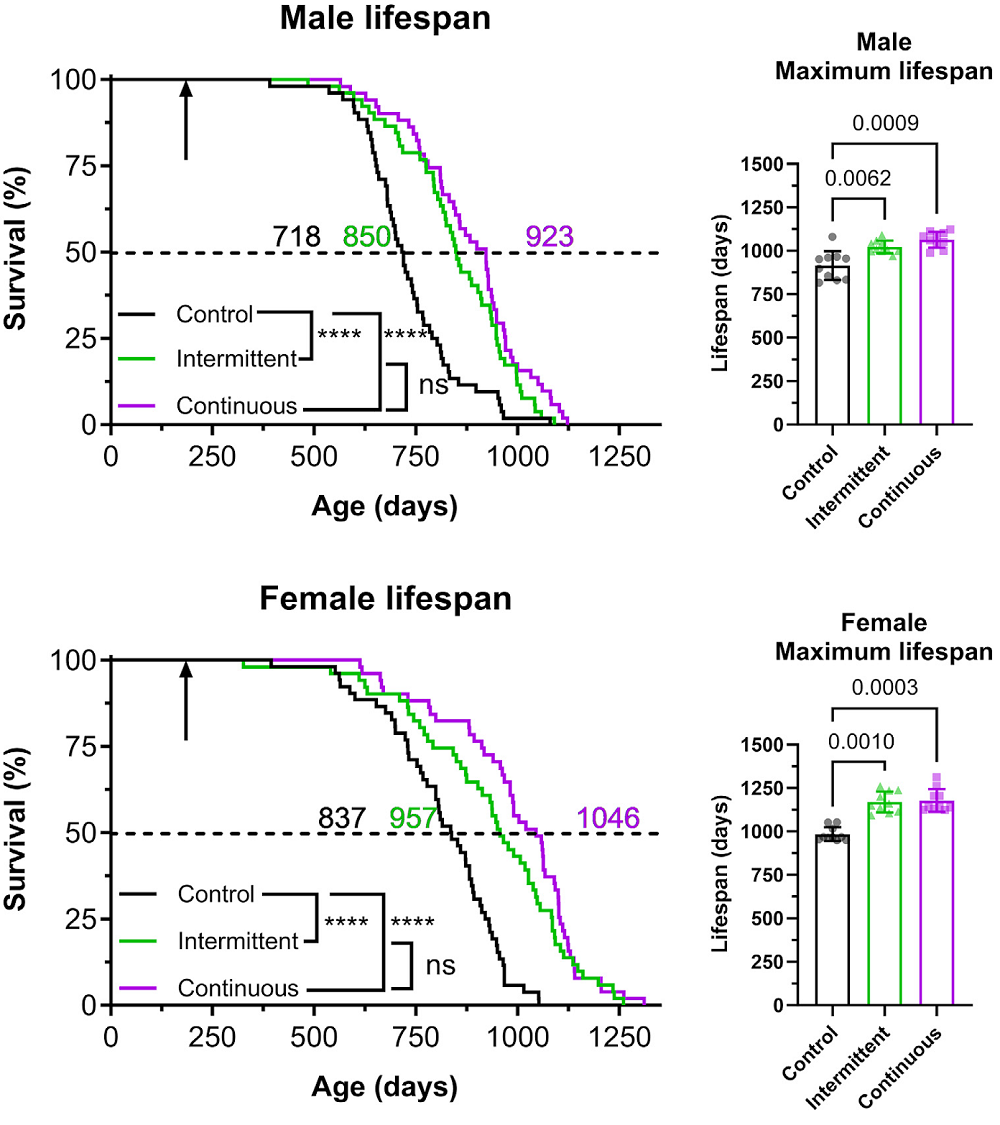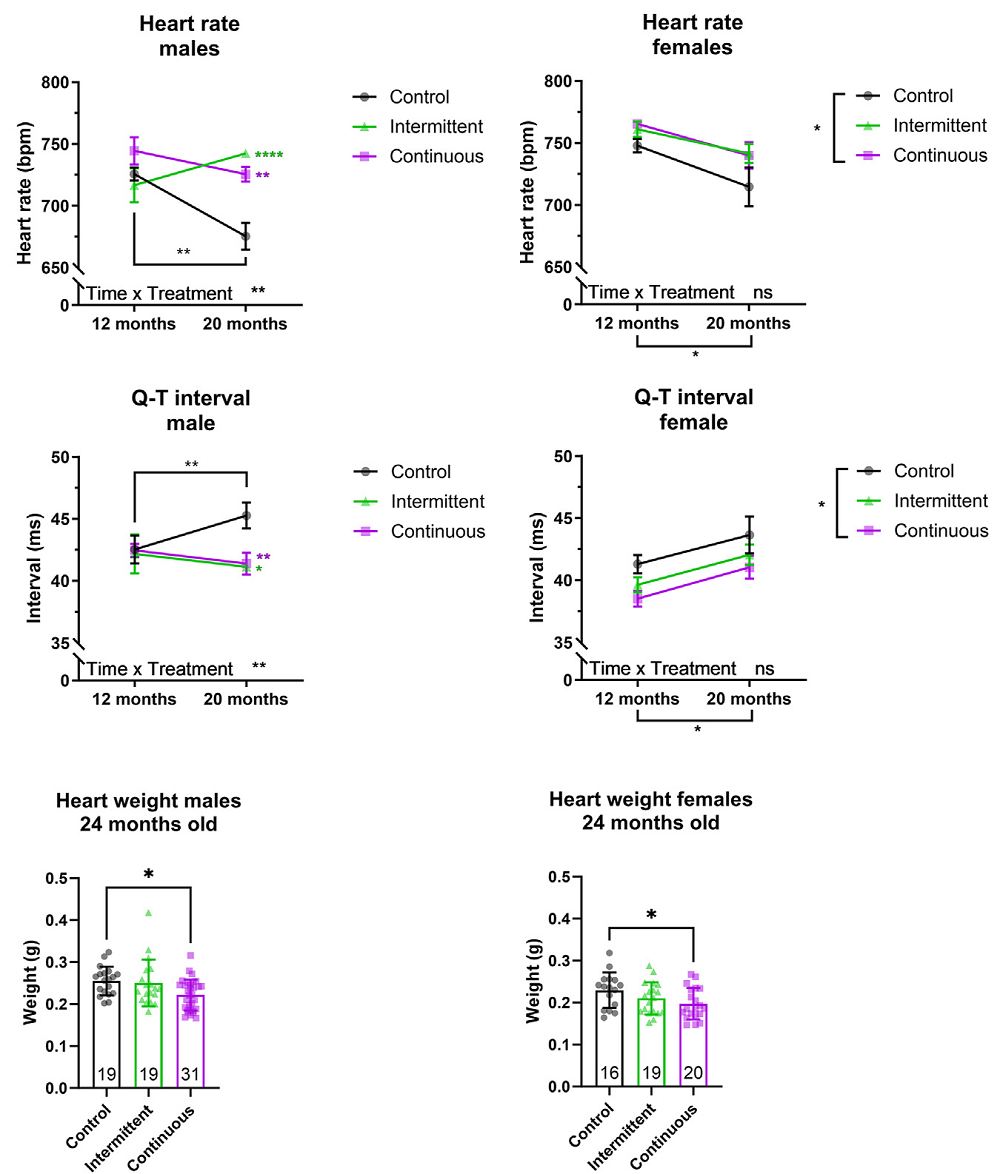A recent Molecular Metabolism paper dives into the differences between intermittent and chronic rapamycin treatment and its differential impact on male and female mice [1].
The dark side of rapamycin
Rapamycin doesn’t need much introduction in the lifespan extension community. This mTOR inhibitor has been shown multiple times to extend lifespan in animal studies. Because of those promising results, rapamycin and rapalogs (rapamycin-based compounds) are viewed as promising geroprotective agents.
Despite the promise of thesecompounds, rapamycin treatment has a dark side. Mouse studies that used chronic rapamycin treatment show that such treatment can lead to “increased incidence of cataracts, testicular degeneration [2], glucose intolerance [3] and reduced blood T regulatory cells [4].”
A solution that avoids these side effects and still provides benefits might be intermittent rapamycin treatment. Studies that embarked on intermittent dosing regiments reported a partial reduction of some adverse effects of rapamycin, such as glucose intolerance [4], while still effectively extending the lifespan of female mice [5].
Lifespan and health outcomes
In this newly published study, the authors investigated the impact of intermittent rapamycin feeding on male and female mice, using the highest rapamycin dose previously reported in the literature to extend lifespan in both sexes from 10 months of age (42 mg/kg). Rapamycin was given with food every other week for the intermittent dosage group.
The researchers measured the rapamycin levels and reported that serum rapamycin levels in mice that were treated with rapamycin every other week were increased while the mice were receiving the drug. However, those levels were lower than in the mice that were treated continuously. When the animals stopped rapamycin treatments, rapamycin levels quickly fell to the levels of control animals. The authors also measured rapamycin levels in different tissues and noticed sex- and tissue-specific differences.
The authors tested different characteristics of mice under the treatment. As would be expected based on the previously well-established role of rapamycin in lifespan extension, intermittent and continuous rapamycin treatments led to an increase in median and maximum lifespan.

The authors also tested many aspects of the mice’s metabolic health, motor skills, physical health, and heart function. Overall, they noticed that some side effects of the chronic treatment were reduced when rapamycin was administered non-continuously, but some of the beneficial aspects of rapamycin treatment were also reduced. Additionally, sex-specific differences were also observed by the researchers.
Intermittent rapamycin treatment didn’t remedy all the side effects of the continuous rapamycin treatment. The researchers observed that intermittent treatment didn’t rescue “the effect of the drug on testicular pathology.” Similarly, heart fibrosis in males and liver lipidosis in both males and females were increased following both treatments.
On the other hand, the appearance of tumors in the liver was reduced following intermittent rapamycin treatment, but continuous treatment was more effective in reducing liver tumors.
Chronic rapamycin treatment led to lower glucose tolerance compared to controls. The intermittent treatments led to increased glucose tolerance in female mice. The effect was particularly noticeable for females during the break from treatment. At that time, the researchers observed glucose tolerance similar to the controls. In males, the effect was ameliorated only during the week when they didn’t receive rapamycin.
Rapamycin also impacted the motor coordination of studied animals. The researchers observed improvements in motor coordination in middle age in males and in old age in both sexes when rapamycin was continuously administered. The same was true for male mice on intermittent rapamycin regimes but not females.
Cardiac functions were also impacted. The authors analyzed the mice’s QT interval, a measurement representing the time it takes the heart’s ventricles to contract and relax. Age is associated with the increase in QT interval, but continuous and intermittent rapamycin treatment was able to rescue that increase in males and significantly decrease it in females.
Additionally, the authors observed “a reduction in age-associated heart rate decrease” in older mice continuously or intermittently treated with rapamycin.
However, there were also some differences. While the authors observed reduced heart weight in male and female mice continuously treated with rapamycin, they didn’t observe it in intermittently fed animals.

Impact on the immune system
Inflammation is known to be associated with aging. The senescence-associated secretory phenotype, or SASP, is a term that describes a mix of pro-inflammatory molecules secreted by senescent cells. Previous research has shown that rapamycin reduces the expression of SASP cytokines. In this study, the researchers also found that rapamycin downregulates several SASP-associated proteins. The treatment was more effective in mice receiving continuous doses of rapamycin compared to intermittent rapamycin treatment. The researchers also noted stronger SASP-related effects in female mice.
They also compared age-associated inflammation in multiple mice tissues. They observed that continuous rapamycin treatment was more effective in reducing inflammation than intermittent treatment.
The spleen plays an important role in the workings of the immune system, as it is the primary site of immune cell production. In advanced age, multiple conditions can lead to the enlargement of the spleen. The authors observed that both continuous and intermittent rapamycin feeding in male and female mice led to a reduction in spleen weight.
The authors also observed that intermittent and continuous rapamycin treatment in males led to a reduction in spleen pathology. The same effect was observed in continuously fed females. Intermittent feeding in females showed a trend in the same direction, but it was not statistically significant.
Contributors to lifespan extension
Based on these results, the authors suggest that traits that are impacted by both intermittent and chronic treatments can be seen as rapamycin’s potential contributors to lifespan extension. Those traits are sex-specific. For males, they are increased motor coordination, spleen weight reduction, heart rate, and QT interval maintenance. For females, they are reduced brown adipose tissue inflammation and spleen weight and the maintenance of heart rate and the QT interval.
Literature
[1] Baghdadi, M., Nespital, T., Monzó, C., Deelen, J., Grönke, S., & Partridge, L. (2024). Intermittent rapamycin feeding recapitulates some effects of continuous treatment while maintaining lifespan extension. Molecular metabolism, 81, 101902. Advance online publication.
[2] Wilkinson, J. E., Burmeister, L., Brooks, S. V., Chan, C. C., Friedline, S., Harrison, D. E., Hejtmancik, J. F., Nadon, N., Strong, R., Wood, L. K., Woodward, M. A., & Miller, R. A. (2012). Rapamycin slows aging in mice. Aging cell, 11(4), 675–682.
[3] Miller, R. A., Harrison, D. E., Astle, C. M., Fernandez, E., Flurkey, K., Han, M., Javors, M. A., Li, X., Nadon, N. L., Nelson, J. F., Pletcher, S., Salmon, A. B., Sharp, Z. D., Van Roekel, S., Winkleman, L., & Strong, R. (2014). Rapamycin-mediated lifespan increase in mice is dose and sex dependent and metabolically distinct from dietary restriction. Aging cell, 13(3), 468–477.
[4] Arriola Apelo, S. I., Neuman, J. C., Baar, E. L., Syed, F. A., Cummings, N. E., Brar, H. K., Pumper, C. P., Kimple, M. E., & Lamming, D. W. (2016). Alternative rapamycin treatment regimens mitigate the impact of rapamycin on glucose homeostasis and the immune system. Aging cell, 15(1), 28–38.
[5] Arriola Apelo, S. I., Pumper, C. P., Baar, E. L., Cummings, N. E., & Lamming, D. W. (2016). Intermittent Administration of Rapamycin Extends the Life Span of Female C57BL/6J Mice. The journals of gerontology. Series A, Biological sciences and medical sciences, 71(7), 876–881.
View the article at lifespan.io









































